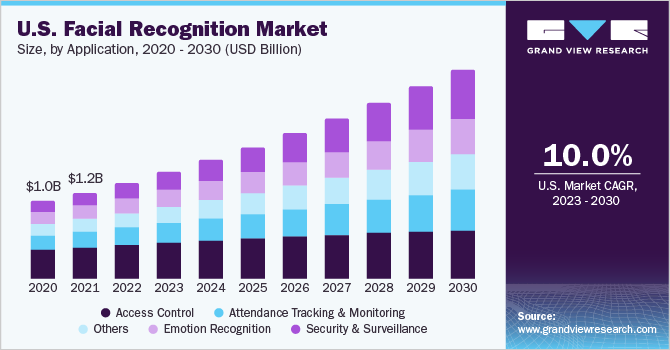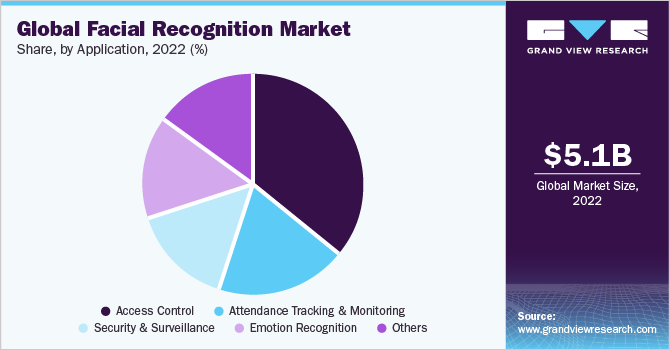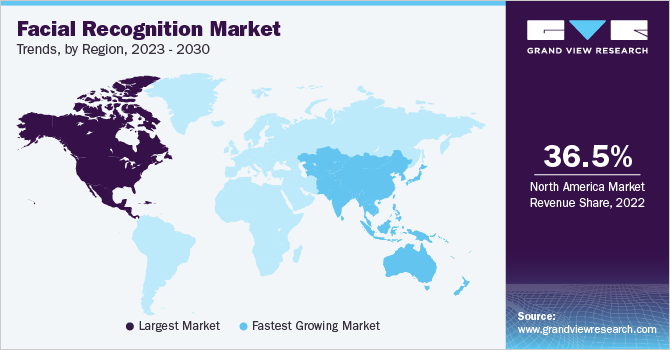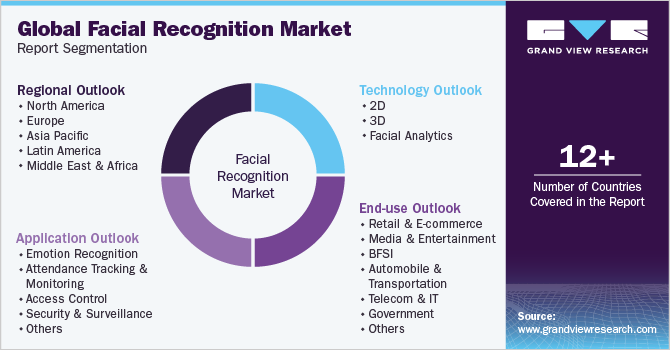- Home
- »
- Next Generation Technologies
- »
-
Facial Recognition Market Size, Share & Trends Report, 2030GVR Report cover
![Facial Recognition Market Size, Share & Trends Report]()
Facial Recognition Market Size, Share & Trends Analysis Report By Technology (2D, 3D, Facial Analytics), By Application (Access Control, Security & Surveillance), By End-use, By Region, And Segment Forecasts, 2023 - 2030
- Report ID: 978-1-68038-311-9
- Number of Report Pages: 92
- Format: PDF, Horizon Databook
- Historical Range: 2017 - 2021
- Forecast Period: 2023 - 2030
- Industry: Technology
Report Overview
The global facial recognition market size was valued at USD 5.15 billion in 2022 and is expected to grow at a compound annual growth rate (CAGR) of 14.9% from 2023 to 2030.Technology is improving, evolving, and expanding at an explosive rate. Technologies such as biometrics are extensively used to enhance security. These are used across various applications, such as access control, attendance tracking, security, and surveillance. Biometrics are universal, unique, and measurable and thus can be used to provide security solutions. Various types of biometrics are used today, such as fingerprints, iris, face recognition, speech, and others. Facial recognition technology is a type of image recognition technology that has gained wide acceptance over the years. This technology leverages a connected or digital camera to detect faces in the captured images and then quantify the features of the image to match against the templates stored in the database.

Facial recognition technology is versatile and is rapidly being used by various end-users. For instance, in January 2020, NEC Corporation, an electronics and information technology company, announced that the company would offer facial recognition technology to Mitsui Fudosan Co., Ltd., a Japan-based real-estate company. The offering includes smart hospitality services, a solution using facial recognition technology. Further, the solution, with the help of facial recognition technology, would help the users with secure and safe stays at hotels. It would be used for various services, including cashless payments, entertainment facilities, entering rooms, and check-in.
The increasing adoption of facial recognition technology across various applications is a driving force for market growth. The border authorities use the technology to verify identities, especially in airports. Law enforcement agencies also use face recognition software to scan faces captured on CCTV and find the targeted person. Another application where the technology has gained prominent adoption is smartphones. In smartphones, the software finds applications for unlocking the phone, signing into mobile apps, and verifying payment.
For instance, in January, Samsung’s Galaxy Note 8 and 9 smartphone models and iPhone X series were the most prevalent devices using facial recognition technology. Other smartphone devices such as OnePlus 6, Oppo Find X, MotoG6, Huawei Honor 7X, and LG G7 use 2D technology and iris scanners for scanning the user’s face. iPhone X face ID consists of a depth sensor, a dot projector, and an infrared camera to map 30,000 points on the user’s face. From this data, the software develops an artificial 3D scan that is safe to unlock phones and authenticate digital payments through Apple Pay.
The rising adoption of the technology by the law enforcement sector is substantially contributing the market growth. For instance, in January 2020, Moscow City announced using live facial recognition cameras provided by NtechLab, an artificial intelligence algorithm developer. The police authority in the city would use facial recognition to search for suspects on a live camera. The software would notify the police when a match is found. In another instance, MorphoTrust, a subsidiary of IDEMIA and one of the most prominent vendors of biometry products and services in the U.S. has developed facial recognition systems for state and federal law enforcement agencies, state DMVs, state departments, and airports.
Technology Insights
The 3D segment held the largest market share of 37.8% in 2022. The advent of advanced technologies, such as cloud-based solutions and facial analytics, is expected to boost market growth. Facial analytics capabilities in facial recognition software allow users to understand where a face exists in a video or image, along with the attributes of the face. For instance, Amazon Rekognition can analyze facial characteristics, including mood, visual geometry, eyes open or closed, and hair color. These attributes help customers organize millions of images using metadata tags. Facial analytics provides high accuracy and detection efficiency. Therefore, it is increasingly used in education and research, retail, healthcare, and police services to determine gender, age, height, and other facial characteristics.
The accuracy provided by 3D technology in facial recognition systems encourages the deployment of these systems for public safety solutions, such as border protection and surveillance. 3D recognition systems are preferred over 2D systems in high-security spaces like airports. For instance, Chenega Europe Ltd., a wholly-owned subsidiary of Chenega Corporation, provides long-range LiDAR-enabled 3D facial recognition for identity acquisition and verification. The company specializes in professional services delivery focused on military and intelligence operations, and its 3D biometric surveillance technology is used by a government in the Middle East to enhance its airport surveillance capabilities.
The facial analytics segment mainly comprises multiple gas extractors and is estimated to exhibit a CAGR of 20.5% over the forecast period. Facial analytics involves analyzing facial features, expressions, and patterns to gain insights into individuals' emotions, demographics, and behavior. The improved accuracy and performance of facial recognition algorithms have fueled the adoption of facial analytics in various industries, including security, retail, healthcare, and marketing.
End-use Insights
Retail & e-commerce dominated the market with the highest revenue share of 21.4% in 2022. The retail and e-commerce sectors have rapidly adopted face recognition technology to enhance operational efficiency and improve the in-store experience. Previously, customers made payment amounts through various payment methods, such as cash, card, or QR code. These payment methods involve diverse POS terminal systems and high staff involvement.
At the same time, adopting facial recognition technology for payment methods eliminates the need for various pieces of hardware. Shoppers can quickly pay the bill by scanning their faces on smart devices or at kiosks, which results in a more secure, fast, and user-friendly payment. It also offers a unique authentication service that identifies and recognizes faces from user databases and, with advancements in computer vision-based machine learning algorithms, can find the shopper's face easily from the entire database.
For instance, in June 2019, Alibaba Group Holding Ltd., a Chinese multinational technology company specializing in e-commerce and retail, and Bestore Co Ltd., a snack manufacturer entered into a partnership to integrate facial recognition technology with Alibaba Group account data. Bestore allows its customers the option of payment via Alibaba's face-scanning tablets and is also using other services offered by Alibaba Group for efficient marketing. Shop assistance will be able to provide better customer service to users whose facial data is stored in the Bestore system, from the moment they enter the store. This partnership is expected to provide an increased sales rate and focused customer experience to the Bestore company.
The healthcare segment is expected to witness significant growth at a CAGR of 17.5% during the forecast period. Healthcare organizations handle sensitive patient information and valuable medical resources, prioritizing security. Facial recognition technology provides an additional layer of security by ensuring that only authorized individuals have access to restricted areas or confidential data. By integrating facial recognition with existing security systems, healthcare facilities can strengthen their overall security infrastructure, deter potential threats, and mitigate the risk of unauthorized access or data breaches.
Due to law enforcement and security demand, the government sector is estimated to experience moderate growth in the forecast period. Owing to the non-intrusive nature of the technology, it is also used for covert monitoring by governmental agencies. This technology is widely used in banking and finance to counter fraud, catering to a substantial market share. This technology is also used in the retail and e-commerce segment to enhance sales. For instance, in June 2019, e-commerce companies Jingdong JD.com and Alibaba.com announced combining facial recognition technology with sales data. This will help the company understand targeted sales behavior and better allocate resources.
Application Insights
The access control segment dominated the market with the highest revenue share of 36.0% in 2022, owing to the rising number of companies focusing on enhancing their access control systems. For instance, in November 2019, Precise Biometrics, an authentication product provider, announced a new product enhancement. The company announced the integration of liveness detection capabilities into physical access control systems based on facial recognition. Such enhancements are driving the adoption of the technology for access control systems, thereby generating higher revenues.

On the other hand, the security & surveillance segment is expected to grow at a significant CAGR of 19.5% over the forecast period, owing to the increased adoption of facial recognition technology in security and surveillance systems and its implementation in high-security areas. For instance, law enforcement agencies use security and surveillance systems to find missing children or uncover criminals’ faces. Also, business owners prefer installing facial recognition-based security systems to monitor people and identify their faces when they arrive at their stores. Furthermore, airports are increasingly deploying facial recognition technology at security checkpoints, as people are less likely to commit crimes when monitored through security systems. Thus, this technology deters the possibility of crime in public spaces.
Regional Insights
North America dominated the market with the largest revenue share of 36.5% in 2022. The major factor contributing to regional growth is the wide implementation of facial recognition technology in security and surveillance systems. In addition, the rising adoption of facial recognition technology in various departments such as homeland security, Justice, and Defense, amongst others across the U.S., is boosting the market growth. For instance, MorphoTrust, a subsidiary of IDEMIA, is one of the most prominent vendors of biometry products and services in the U.S. It has developed facial recognition systems for state and federal law enforcement agencies, state DMVs, state departments, and airports. Key European markets of the U.K., France, and Germany are expected to drive the regional market considerably over the forecast period.

Key players have partnered with retailers, distributors, and system integrators to market and sell their products to a large customer base. For instance, in May 2020, FacePhi signed an agreement with Nubi Fintech, an Argentina-based financial services company, to incorporate FacePhi's biometric recognition technology into Nubi's services. Under the agreement, Nubi Fintech will integrate the SelphID biometric solution with its mobile application to enable secure authentication and a better user experience.
The Asia Pacific region is expected to grow at the fastest CAGR of 18.5% during the forecast period. Facial recognition technology is widely used in developing countries like India to solve investigation cases. For instance, in April 2018, face recognition was used by an Indian police force in New Delhi to identify children who have been lost or kidnapped. It was used on approximately 45,000 children throughout the city, of which around 3000 were found missing. Several countries in the APAC region are taking initiatives to generate electronic IDs for individuals. Initiatives such as the e-KTP project in Indonesia and the UIDAI project in India are creating new opportunities for market penetration in the region.
Facial recognition technology is the digital mapping of an individual's facial geometry using biometrics. The facial geometry includes features such as the nose's width, the distance between the eyes, and the distance between the forehead and chin, among others. These measurements are then used to create a mathematical formula called a facial signature. The stored signature is used to compare the physical structure of an individual's face to verify their identity. Facial recognition is a robust method for safeguarding data as it is used for authentication to unlock mobile devices.
This technology has significantly enhanced business operations, including access and authentication, identity fraud prevention, and accessibility to accounts and services. As a result, facial recognition platforms have become increasingly popular across several industry verticals, including banking and financial services, retail and e-commerce, automotive and transportation, media and entertainment, IT and telecom, government and the public sector, and others. For instance, in airports, biometric self-boarding gates that use facial recognition technology to verify the identity of passengers by capturing their photos have been deployed in several countries.
Key Companies & Market Share Insights
Vendors in the market are undertaking numerous strategic initiatives, such as acquisitions and mergers, collaborations, new product developments, and partnerships with other prominent players. Continuous R&D to offer product differentiation is expected to be the major success factor for industry participants. For instance, companies such as Ayonix Corporation specialize in offering face recognition technology in sectors such as banking, hospitality, and retail.
Some vendors are also concentrating on collaboration and acquisitions to augment their product offerings, thereby helping them to gain a competitive edge in the market. For another instance, in April 2020, FacePhi signed an agreement with Creditel (SOCUR S.A.), a Uruguayan financial entity. Under the agreement, Creditel will incorporate FacePhi biometric recognition solution SelphID in their security systems. The company has taken this strategic initiative to strengthen its presence in the Latin American market.
Recent Developments
-
In March 2022, Salto Group announced the acquisition of Cognitec Systems, a move aimed at incorporating face biometrics into its access control portfolio. This strategic acquisition is anticipated to bolster Cognitec's research and development endeavors while expanding its market reach for its product portfolio. Collaborating with Salto, Cognitec will focus on developing new technologies to cater to the growing biometric markets. Integrating face biometrics into Salto's access control solutions is expected to enhance security measures and provide advanced authentication capabilities for various applications.
-
In March 2022, NEC, a leading technology company, provided Brunei authorities with facial recognition technology to support the Department of Internal Security's ongoing efforts to enhance security measures. By implementing this advanced facial recognition system, the department aims to strengthen security coverage and effectively address new and emerging threats, particularly counterterrorism. The technology will aid in identifying and verifying individuals, contributing to the overall security objectives of Brunei.
-
In July 2022, Secunet, a security and biometric company headquartered in Germany, has recently announced its collaboration with Zurich Airport to implement its technologies and ensure compliance with the European Entry/Exit System (EES). The EES initiative mandates that third-country nationals provide a facial image and four fingerprints for registration when crossing the borders of the Schengen area via land, sea, and air routes. By equipping Zurich Airport with Secunet's advanced solutions, the airport will be able to meet the requirements of the EES scheme effectively.
Some prominent players in the global facial recognition market include:
-
Aware, Inc.
-
Cognitec Systems GmbH
-
Ayonix Corporation
-
Thales
-
Fujitsu
-
FacePhi
-
NEC Corporation
-
Onfido
-
TECH5
Facial Recognition Market Report Scope
Report Attribute
Details
Market size value in 2023
USD 5.98 billion
Revenue forecast 2030
USD 15.84 billion
Growth Rate
CAGR of 14.9% from 2023 to 2030
Base year for estimation
2022
Historical data
2017 - 2021
Forecast period
2023 - 2030
Report updated
August 2023
Quantitative units
Revenue in USD million/billion and CAGR from 2023 to 2030
Report coverage
Revenue forecast, company ranking, competitive landscape, growth factors, and trends
Segments covered
Technology, application, end-use, region
Regional scope
North America; Europe; Asia Pacific; Latin America; MEA
Country scope
U.S.; Canada; U.K.; Germany; France; Japan; China; India; Australia; South Korea; Brazil; Mexico; Saudi Arabia; South Africa; UAE
Key companies profiled
Aware, Inc.; Cognitec Systems GmbH; Ayonix Corporation; Thales; Fujitsu; FacePhi; NEC Corporation; Onfido; TECH5
Customization scope
Free report customization (equivalent up to 8 analyst’s working days) with purchase. Addition or alteration to country, regional & segment scope
Pricing and purchase options
Avail customized purchase options to meet your exact research needs. Explore purchase options
Global Facial Recognition Market Report Segmentation
This report forecasts revenue growth at global, regional, and country levels and provides an analysis of the latest industry trends in each of the sub-segments from 2017 to 2030. For this study, Grand View Research has segmented the global facial recognition marketreport based on technology, application, end-use, and region:

-
Technology Outlook (Revenue in USD Million, 2017 - 2030)
-
2D
-
3D
-
Facial Analytics
-
-
Application Outlook (Revenue in USD Million, 2017 - 2030)
-
Emotion Recognition
-
Attendance Tracking and Monitoring
-
Access Control
-
Security & Surveillance
-
Others
-
-
End-use Outlook (Revenue in USD Million, 2017 - 2030)
-
Retail & E-commerce
-
Media & Entertainment
-
BFSI
-
Automobile & Transportation
-
Telecom & IT
-
Government
-
Healthcare
-
Others
-
-
Regional Outlook (Revenue in USD Million, 2017 - 2030)
-
North America
-
U.S.
-
Canada
-
Europe
-
UK
-
Germany
-
France
-
Asia Pacific
-
Japan
-
China
-
India
-
Australia
-
South Korea
-
Latin America
-
Brazil
-
Mexico
-
Middle East & Africa
-
South Africa
-
Saudi Arabia
-
UAE
-
Frequently Asked Questions About This Report
b. North America region dominated the facial recognition market in 2022, accounting for over 36% share of the global revenue.
b. Some key players operating in the facial recognition market include Aware, Inc.; FacePhi.; NEC Corporation; IDEMIA; TECH5; Onfido; Ayonix Corporation; Gemalto NV; Cognitec Systems GmbH; Precise Biometrics; NtechLab; and Fujitsu.
b. Key factors that are driving the facial recognition market growth include technological advancements such as 3D recognition systems and cloud-based solutions and the growing adoption of face recognition in different verticals.
b. The global facial recognition market size was estimated at USD 5.15 billion in 2022 and is expected to reach USD 5.98 billion in 2023.
b. The global facial recognition market is expected to grow at a compound annual growth rate of 14.9% from 2023 to 2030 to reach USD 15.84 billion by 2030.
b. The 3D segment led the facial recognition market in 2022, accounting for over 35% share of the global revenue.
Share this report with your colleague or friend.
![gvr icn]()
NEED A CUSTOM REPORT?
We can customize every report - free of charge - including purchasing stand-alone sections or country-level reports, as well as offer affordable discounts for start-ups & universities. Contact us now
![Certified Icon]()
We are GDPR and CCPA compliant! Your transaction & personal information is safe and secure. For more details, please read our privacy policy.
We are committed towards customer satisfaction, and quality service.
"The quality of research they have done for us has been excellent."





